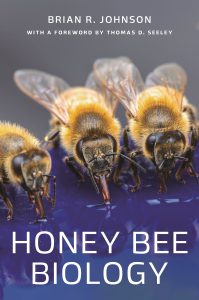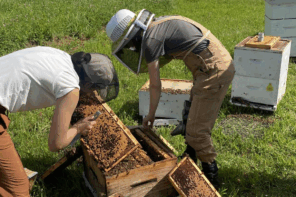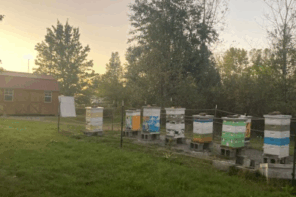By: Mark Winston
Books about honey bees gravitate towards two poles: practical guides to beekeeping, and works on biology. While beekeeping books are of interest primarily to beekeepers or beekeeping wannabees, books focused on biology are of wider interest, for the simple reason that honey bees are fascinating.
Writing about bees goes back thousands of years, showing a gradual transition from observations, some accurate and some not, to synthetic works that draw from the immense and still-expanding scientific scrutiny that has focused on every aspect of honey bee biology. The earliest commonly cited work, Aristotle’s Generation of Animals, from about 2300 years ago, proposed that bees are divine, and mistakes the queen for a king. He correctly noted that bees collect honey from the “juice of flowers,” and recognized a second food, “bee bread,” carried home from the field on their legs, that has a “sweet, figlike taste.” He also recorded the first observations of chemical communication, writing that “if a young swarm goes astray, it will turn back upon its route and by the aid of scent seek out its leader.”
Charles Butler’s The Feminine Monarchie (1609) is widely cited as the first scientific treatise on honey bees. Butler understood that the monarch was a queen, and provided some practical advice about beekeeping. Still, the full title indicates that it was still a fair bit away from the hard-science tone of more recent books: The Historie of Bees Shewing Their Admirable Nature, and Properties, Their Generation, and Colonies, Their Gouernment, Loyaltie, Art, Industrie, Enemies, Warres, Magnamimitie, &c. Together with the Right Ordering of Them from Time to Time: and the Sweet Profit Arising Thereof.
Maeterlinck’s The Life of the Bee (1901) provided a further transition from natural history and observation to more rigorous science, albeit tinged with a heavy dose of philosophy. He introduced experimentation into the bee biology canon, letting a forager find a dish of sugar syrup and preventing her from leaving after she re-entered her nest. Yet, other bees quickly went to the feeder, suggesting the returning forager was passing on information to nest mates. He also wrote eloquently and more spiritually about the “spirit of the hive… the incomprehensible organization of the most insignificant act of life.”
In 1953, British scientist Ronald Ribbands published the first modern synthesis that relied primarily on scientific studies, The Behavior and Social Life of Honeybees. His book not only summarized what was known at the time, relying heavily on scientific papers, but was written in clear prose easily understood by beekeepers and a broad public audience. Tragically, he was struck by a car while helping another driver change a flat tire in the early 1960’s, and never had a chance to revise his book with the many studies of the 1950’s and beyond that dramatically expanded our understanding of honey bee biology.

I took up the mantle in the 1980’s, inspired by Ribbands, with my first book The Biology of the Honey Bee (1987). I wrote with beekeepers in mind, wanting a book that was comprehensive and based in scientific studies, but also readable. I’ll leave it to readers whether I was successful, but as the years went on, one thing was increasingly clear: the book was rapidly going out of date, and required a substantial overhaul in a new edition.
I never did revise my book, because I got involved in other projects, and the work to update was daunting due to the proliferation of honey bee research since 1987. But most significantly I felt that a younger, more contemporary voice was required. My time was the era of behavioral ecology, studying bee behavior in the context of interactions within the hive and with the external world. Today’s bee research has taken a much deeper dive into genetics, molecular biology, neurobiology and biochemistry, not only as separate disciplines but also integrating the approaches of these disparate fields.
A new book summarizing what we know about honey bees has been sorely needed for at least a decade or two, and fortunately one has just been published, by author Brian Johnson, a professor at the University of California, Davis. It’s a pleasure to report that Honey Bee Biology (2023, Princeton University Press) is a most worthy addition to the procession of books about honey bees stretching back well over 2,000 years.
Writing a book about honey bee biology today is difficult terrain to navigate, due to the increasingly technical nature of research, and the sheer volume of studies. Johnson does an admirable job of steering between the detail and precision expected from complex science, and writing for a public audience, producing a book that is both comprehensive and readable. “Comprehensive” is an understatement; there are 123 pages of references at the end, with about 2,100 cited publications. For comparison, my book The Biology of the Honey Bee had around 800 references, which covered most of what was known then. The considerably higher number Johnson referenced is indicative of just how much honey bee research has expanded, as well as his commitment to broadly present the array of knowledge that honey bee science has to offer.
He covers the basic and expected topics of anatomy, development, reproduction, division of labor, foraging, nesting, pheromones and more, bringing readers up to date on the latest findings. Perhaps the greatest strength of Johnson’s approach is that Honey Bee Biology goes well beyond what we know to describe how we know it, with clear and engaging explanations of key observations and rigorous experiments that let readers into the rooms where science is designed and conducted. He also prolifically articulates areas where further research might be particularly productive, so that the book is an excellent primer for students and young professors seeking research topics.
Johnson also presents synthesizing chapters focused on genetics, genomics, neurobiology, cognitive science, social immunity and evolution, although these segments are more technical and require a bit of effort for non-scientific civilians to fully comprehend. Still, even a superficial read of these more difficult sections yields the essence of contemporary honey bee research, a flavor that connects diverse topics to create a fuller understanding of the remarkable behaviors and organization of honey bee society.
Johnson also does readers a great service by presenting controversies in honey bee science in a balanced, respectful fashion. He has a particularly deft touch in covering issues around which there is still disagreement, and either comes down on one side of an issue where he thinks the data supports it, or leaves the reader with the understanding that we still just don’t know.
For example, honey bee colonies are made up of many subfamilies with different drone fathers, and while many sociobiologists have speculated that each subfamily would favor their own kin, Johnson notes that on balance, the data doesn’t support that theory, but that there’s just not enough research for a conclusive conclusion. Another example is the question of whether honey bee colonies are cooperative, working communally towards common purpose, or competitive, with individuals subtly attempting to “win” through queen rearing or various aggressive behaviors. Here, Johnson has a firmer opinion, coming down on the side of more cooperation than conflict, while recognizing even harmonious cooperating societies may nevertheless express some internal conflict.
He concludes with a few chapters that will be of special interest to beekeepers, focused on parasites, pests and pathogens, detoxification and pesticides, and honey bees as managed pollinators. These chapters are less how-to, and more about how research has informed beekeeping practices, and in that way extends basic biology into practical applications.
Writing a book about honey bee biology presents a special writing challenge because of the breadth of the audience interested in bees. Scientists want a book they can use as a reference, beekeepers read out of interest but also to understand the biology underlying management decisions, and the general public has a great appetite for fascinating biology and clearly explained science.
To thread that needle for all three audiences is a daunting task, but Johnson pulls it off. I’m pleased to recommend Honey Bee Biology for all readers, from scientists to beekeepers to the public. I wish Brian Johnson all success as he joins the pantheon of writers through the ages who have graced us by illuminating the science underlying the spirit of the hive.
Mark L. Winston is a Professor Emeritus and Senior Fellow at Simon Fraser University’s Centre for Dialogue. His most recent books have won numerous awards, including a Governor General’s Literary Award for Bee Time: Lessons from the Hive, and an Independent Publisher’s Gold Medal for Listening to the Bees, co-authored with poet Renee Sarojini Saklikar.









